CALIFORNIA DARK-RUMPED PETRELS:
HAWAIIAN vs. GALAPAGOS PETREL
A PRELIMINARY INVESTIGATION
comments by D. Roberson
NOTE: This page is long, detailed, complex,
and full of photos. Some are shown multiple times to make different points.
You may wish to print out the page to consider at your leisure.
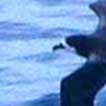
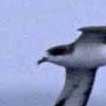 It
is now widely reported that the A.O.U. has voted to split Dark-rumped Petrel
into two species: Galapagos Petrel Pterodroma phaeopygia and Hawaiian
Petrel P. sandwichensis. This decision follows research that showed
the two taxa differed in vocalizations, morphology, and breeding seasons
(Tomkins & Milne 1991), and biochemically (Nunn et al. 2000), and follows
the decision of other authorities that have considered them separate species
from the perspective of the biological species concept (e.g., Birdlife
International 2000). Both are endangered species. The Galapagos Petrel
has declined 80% in the last sixty years but seems to be rebounding recently
with the extirpation of non-native predators; its world population is estimated
at 88,000 birds (20,000 breeding pairs plus subadults; Spear et al. 1995).
The Hawaiian Petrel has been declining rapidly. There are small populations
on Maui, Hawaii, Lanai (and maybe Molokai); its world population is estimated
at 19,000 birds (3750-4500 breeding pairs plus subadults; Spear et al.
1995).
It
is now widely reported that the A.O.U. has voted to split Dark-rumped Petrel
into two species: Galapagos Petrel Pterodroma phaeopygia and Hawaiian
Petrel P. sandwichensis. This decision follows research that showed
the two taxa differed in vocalizations, morphology, and breeding seasons
(Tomkins & Milne 1991), and biochemically (Nunn et al. 2000), and follows
the decision of other authorities that have considered them separate species
from the perspective of the biological species concept (e.g., Birdlife
International 2000). Both are endangered species. The Galapagos Petrel
has declined 80% in the last sixty years but seems to be rebounding recently
with the extirpation of non-native predators; its world population is estimated
at 88,000 birds (20,000 breeding pairs plus subadults; Spear et al. 1995).
The Hawaiian Petrel has been declining rapidly. There are small populations
on Maui, Hawaii, Lanai (and maybe Molokai); its world population is estimated
at 19,000 birds (3750-4500 breeding pairs plus subadults; Spear et al.
1995).
With this decision (apparently to be published formally in July 2002),
California birders will inquire which species of 'Dark-rumped Petrel' has
occurred off California. There are now a dozen records within California's
200 nmi limit, and at least two others just to the west or northwest (chronologically
the first records). These are:
|
DATE
|
LOCATION
|
COMMENTS ON EVIDENCE
|
| 19 Oct 1986 |
270 nmi off Cape Arago, Oregon |
Brief description published by Pyle et al. 1993 |
| 2 Aug 1991 |
226 nmi WSW San Miguel I. SBA |
Brief description published by Pyle et al. 1993 |
| 3 May 1992 |
35 mi sw. SE Farallon I. SF |
Description only, no photos; CBRC accepted |
| 26 Jun 1994 |
30 nmi SW of Cypress Pt. MTY |
Stephen C. Rottenborn © photos on this page |
| 24 Aug 1996 |
Cordell Bank MRN |
Description only, no photos; CBRC accepted |
| 27 Jul 1996 |
70 nmi W of Cape Mendocino HUM |
Description only, no photos; CBRC accepted |
| 31 Jul 1996 (2) |
24 nmi SW of San Miguel I. SBA |
Description only, no photos; CBRC accepted |
| 1 Aug 1997 |
Cordell Bank MRN |
Marcel Holyoak & Scott B. Terrill © photos here |
| 15 Jul 2000 |
Cordell Bank MRN |
Eric W. Preston © photos on this page |
| 19 Aug 2000 |
8 nmi off Ft. Bragg MEN |
Photo'd but none currently available? |
| 28 Apr 2001 |
35 nmi W of Pt. Conception SBA |
sketch on-line |
| 25 Jul 2001 |
~100 nmi W of Pt. Conception SBA |
Description only (to CBRC) |
| 18 Aug 2001 |
8 nmi off Ft. Bragg MEN |
Description & sketch on-line |
The entire date span is from late April to mid-October, but the 71%
(10) from July-August seem to be at the real peak. The normal at-sea distribution
is summarized by Spear et al. (1995). While they were unable to separate
the two taxa in the field, their surveys (plus those of Pitman 1986) showed
that there were two distinct areas of occurrence centered around the Galapagos
and Hawaiian islands. Birds were either within 1500 km of the Galapagos
or within 2200 km of Hawaii. Only two 'Dark-rumped Petrels' were seen in
the 1050 km gap between 120°W to 130°W indicating little overlap.
It has generally been assumed that birds west of 130°W and north of
10°N were Hawaiian Petrels, and birds east of 120°W and south of
10°N were Galapagos Petrels (e.g., Spear et al. 1995, Simon & Hodges
1998, Birdlife International 2000; indeed, Scott Terrill's photos of the
1 Aug 1997 bird are on line on a
governmental(?) website without attribution as illustrating "Hawaiian
Petrel"!). Thus it is generally assumed that California birds are Hawaiian
Petrels on distributional grounds but little supporting evidence has been
published.
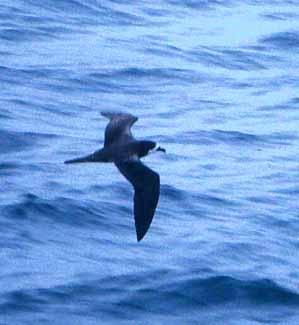 My own field experience is with good numbers of Galapagos Petrel at sea
between Isabella & Santa Cruz Is. on 24 Sep 1989 (photos of a number
of these), and then numbers of birds from south & east of Isabella
I., Galapagos in late September, which were scattered down past the Equator
in October 1989, with birds as far south as 4°S (off n. Peru) in mid
November. I have seen hundreds of Galapagos Petrels at sea. In addition,
I saw a single 'Dark-rumped Petrel' off Mendocino Co, California, 18 Aug
2001. I remarked to several on the boat at the time that the California
bird differed from my recollections of Galapagos birds in that, although
it was long-tailed for a Pterodroma, it didn't match my recollections
of the very long-tailed & pointed-tailed Galapagos birds. Galapagos
birds I recall are characterized by the photo (left or above) that I took
between Isabella & Santa Cruz Is. on 24 Sep 1989 (© 2001 D. Roberson).
Note the long and pointed tail, but also notice the thick, hefty
bill.
My own field experience is with good numbers of Galapagos Petrel at sea
between Isabella & Santa Cruz Is. on 24 Sep 1989 (photos of a number
of these), and then numbers of birds from south & east of Isabella
I., Galapagos in late September, which were scattered down past the Equator
in October 1989, with birds as far south as 4°S (off n. Peru) in mid
November. I have seen hundreds of Galapagos Petrels at sea. In addition,
I saw a single 'Dark-rumped Petrel' off Mendocino Co, California, 18 Aug
2001. I remarked to several on the boat at the time that the California
bird differed from my recollections of Galapagos birds in that, although
it was long-tailed for a Pterodroma, it didn't match my recollections
of the very long-tailed & pointed-tailed Galapagos birds. Galapagos
birds I recall are characterized by the photo (left or above) that I took
between Isabella & Santa Cruz Is. on 24 Sep 1989 (© 2001 D. Roberson).
Note the long and pointed tail, but also notice the thick, hefty
bill.
Since that time I have gathered literature and photos in an attempt
to shed some light on the California situation. I present here the results
of a preliminary investigation into the question of whether California
records of Dark-rumped Petrel are of Galapagos Petrels or Hawaiian
Petrels or both, or whether we can even offer an opinion. I conclude that
the evidence is strong enough to offer a preliminary opinion. However,
the evidence here is partial only. I compared photos of known Galapagos
Petrels with photos of unknown taxa off California and considered whether
the photos appear to match or not. I considered the literature on the topic.
I do not have at-sea photos of Hawaiian Petrels to compare to California
birds (and see below regarding published photos). Thus this preliminary
opinion is circumstantial and indirect.
Tomkins & Milne (1991) published an extensive study of intraisland
variation of Galapagos Petrels, weighing & measuring over 120 birds
from six breeding populations (plus taping vocalizations and studying breeding
ecology). They compared these findings to the studies on Hawaiian Petrel
(Simon 1985); I have also reviewed the recent fascicle in the BONA series
by Simon & Hodges (1998) to update any critical details. There statistical
analyses of morphometric data showed significant differences between Galapagos
and Hawaiian Petrels in culmen length, bill depth, wing length, and tail
length; the Galapagos Petrel was larger in all these measurements (and
in tarsus length which will be of no help here). The Galapagos sample has
many more birds (n=117-127 in any parameter) than the Hawaiian sample (n=8-12
per parameter), but the Galapagos sample includes all the intraisland variation
(see below). Here are some of those statistics (in mm):
| |
GALAPAGOS
mean & (standard deviation)
|
HAWAIIAN
mean & (standard deviation)
|
|
Culmen length
|
33.6 (1.2)
|
31.1 (1.5)
|
|
Bill depth
|
11.3 (0.6)
|
10.6 (0.7)
|
|
Wing length
|
312 (9)
|
291 (8)
|
|
Tail length
|
144 (5)
|
139 (7)
|
In summary, these data show that the typical Galapagos Petrel has a bill
8 % longer and 7% thicker than the typical Hawaiian Petrel, or, in other
words, it should look somewhat bigger billed. The Galapagos wing (that
is, its longest primary) is also about 7 % longer, and its tail about 4%
longer, than Hawaiian birds. Those who have considered these points before
have expressed skepticism that these differences can be distinguished in
the field (e.g., Pyle et al. 1993, Spear et al. 1995, Howell & Pyle
1997, Simon & Hodges 1998). What has not been tested is whether they
might be distinguished in photographs. [Although they have shorter wings
and tails, Hawaiian birds are heavier than Galapagos birds (Simon 1985,
Tomkins & Milne 1991) and have different wing loading (see also Spear
et al. 1995). One would expect their flights to be somewhat different but
no one has mentioned this in the field, and we can't check it in photos.]
Compare this set of photos of four different birds for bill size:
To my eye, the top two have smaller thinner bills compared to the larger
thicker bills on the two below. Not huge dramatic differences but apparent
nonetheless. The top two photos are of California birds [1 Aug 1997 ©
Marcel Holyoak & 15 July 2000 © Eric W. Preston, respectively)
and the bottom two birds are Galapagos Petrels near Santa Cruz I. [24 Sep
1989 © D. Roberson]. This looks to me to be consistent with Galapagos
Petrels having heavier bills if we assume that California birds are Hawaiian
Petrels.
Now let's compare tail length and wing length on these photos of four
different birds:


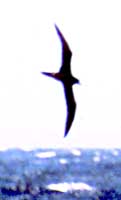

Turning first to tail length, to my eye the
left bird (larger photo) has the longest tail. The two smaller photos in
the middle have similar tail lengths (one bird is holding its tail more
pointed). The last photo is of a bird with the shortest tail (and it isn't
pointed much at all). The first and last photos are of Galapagos Petrels
and the middle two shots of birds off California [1 Aug 1997 © Scott
B. Terrill & 26 June 1994 © Stephen C. Rottenborn, respectively].
But tail length on the final photo from the Galapagos should be ignored.
That bird is in active molt. It is hard to see on this web-published photo
but review of the original slide shows molt on the inner primaries, the
secondaries, the greater upperwing coverts, and the back. It seems quite
likely that the tail is also in molt or growing in. All the other birds
seem to be in good plumage without apparent molt. Again, the evidence is
consistent with Galapagos birds (in good plumage) having longer tails than
Hawaiian birds, if we assume that the California birds are Hawaiian Petrels.
[Also note that to the extent we can see bills,
the Galapagos birds both look big-billed and the California birds thin-billed
in comparison.]
Comparing wing shape, I notice something
else of interest. Obviously the first bird and the last bird are holding
their wings differently, and the first bird has its wings bent somewhat
in mid-stroke so it is hard to say much about shape. But the wings are
held rather similarly open in the small three photos. Note how similar
the wing shape of the two California birds are. Then see how the wings
in the last photo of the Galapagos bird (in molt elsewhere but not in outer
primaries) look somewhat longer. This seems not to be so much because the
primaries are longer but, rather, that the inner half of the wing -- from
the body to the "wrist" -- looks a bit longer. This is a parameter that
is never measured in standard studies, but it can give some species a disproportionately
long-winged effect in the field (cf. Cook's Petrel vs. other small Pterodroma;
Roberson & Bailey 1991).
Note this same concept in the following three shots; the left two from
California (15 July 2000 © Eric W. Preston) and the righthand from
the Galapagos (Sep 1989 © D. Roberson)
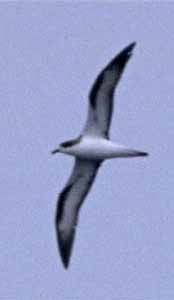

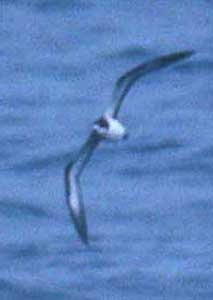
The following set of photos show two California birds (top left 15 July
2000 © Eric W. Preston; bottom left 1 Aug 1997 © Marcel Holyoak;
bottom right 1 Aug 1997 © Scott B. Terrill) and one Galapagos Petrel
(upper right 24 Sep 1989 © D. Roberson). Again I am impressed how
all
the California birds from different years look so similar in bill size,
wing shape, and tail length -- consistent with the idea they are all one
species -- and how they differ from the bigger billed Galapagos Petrel.
Note also the similarities in underwing pattern of all the California birds
and the possibility that the Galapagos Petrel has a slightly narrower black
margin to the leading edge of the underwing.
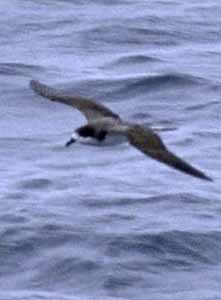
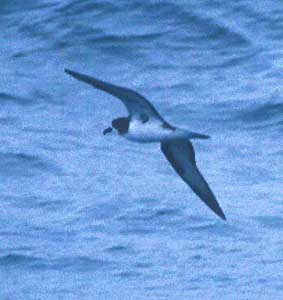
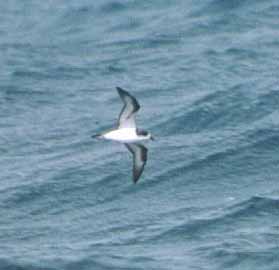
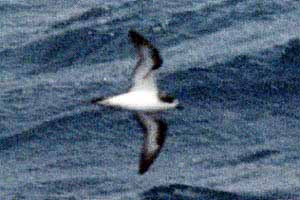
A point to be made about the bottom two photos taken by different photographers
just seconds apart (1 Aug 1997). Differences in film will affect perceptions.
The left-hand photo was taken with Fujichrome Velvia ASA 50 slide film
with a Canon 300mm lens (© Marcel Holyoak) and the right-hand photos
was taken with 800 speed Kodak print film with a Minolta body with a 150x300
zoom lens with a 2X converter (© Scott B. Terrill). The latter film
has much more grain than the fine-grained left-hand shot. Thus, the righthand
bird's bill is lost in the grain somewhat and therefore looks more diffuse
or "larger," but the actual bill size if shown on the lefthand photo (Velvia
50 is the sharpest slide film currently available). This was a small-billed
bird. One must always keep in mind the effect of film grain (and any fuzziness
in focus or shutter-length) in evaluating photographs.
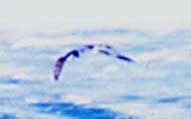 Here is yet another shot of a California bird different than the two shown
immediately above. This particular photo does not come out very well on
the 'Net but the dark head is to the left and under the left wing, and
looks to have a thin bill (just like the other California photos). This
one is the 26 June 1994 bird (© Stephen C. Rottenborn) and a better
rendition is published in Howell & Pyle (1997, W. Birds 28:
126). My own review of my copy of the original found that it looked small-billed.
Thus all California records photographed have been of remarkably similar
birds. Of minor note, the on-line sketches of birds off California on 28
Apr 2001 and 18
Aug 2001 have similar wing and tail proportions to the photographed
California birds [my own sketch was done long before I researched any of
this, and long before I knew which way the measurements should go. However,
bill size/shapes in the sketches were not critically studied and don't
mean anything].
Here is yet another shot of a California bird different than the two shown
immediately above. This particular photo does not come out very well on
the 'Net but the dark head is to the left and under the left wing, and
looks to have a thin bill (just like the other California photos). This
one is the 26 June 1994 bird (© Stephen C. Rottenborn) and a better
rendition is published in Howell & Pyle (1997, W. Birds 28:
126). My own review of my copy of the original found that it looked small-billed.
Thus all California records photographed have been of remarkably similar
birds. Of minor note, the on-line sketches of birds off California on 28
Apr 2001 and 18
Aug 2001 have similar wing and tail proportions to the photographed
California birds [my own sketch was done long before I researched any of
this, and long before I knew which way the measurements should go. However,
bill size/shapes in the sketches were not critically studied and don't
mean anything].
Tomkins & Milne (1991) also focused on intraisland variation in
the Galapagos. There are four islands with populations (Santa Cruz, San
Cristobol, Santiago, Floreana) but on two of those islands (San Cristobol,
Floreana) colonies of birds are nesting at different times of the year.
Thus six breeding populations were analyzed. The mean on bill length is
rather similar in all the populations (running in the 33-34 mm range) and
almost all populations are thick-billed (over 11 mm) but the mid-year nesting
birds on San Cristobol have a bit thinner bills (mean=10.6). Wing length
means run 307-318 with Santa Cruz birds being the shortest winged birds.
Most importantly, tail length is 145-146 mm in all populations except on
Santa Cruz, where tail length averages shorter (mean=141 mm).
My photos were all taken in the channel west of Santa Cruz. It makes
sense that most, if not all, birds are of that Santa Cruz population. Thus
is seems likely that my "long-tailed" photo repeated three (3) times on
this site is actually of a "short-tailed" Santa Cruz I. bird, and therefore
the "typical" Galapagos Petrel is even more long-tailed appearing in the
field than in my photo. This suggests that tail length could turn out to
be a field character.
Next, let's consider molt timing. These petrels molt after the breeding
season. Galapagos populations nest at different times of year, and birds
are therefore nesting on some islands in almost any month. This means Galapagos
Petrels could be in active molt at any time of year, depending on the population
to which the individual belongs. In addition, birds in this group
do not begin breeding until they are six (6) years old (Spear et al. 1995)
and these non-breeders can molt earlier than nesting adults who were feeding
young.
Hawaiian Petrels' breeding is apparently more synchronized (Simon 1985,
Simon & Hodges 1998). The nice chart in Simon (1985) shows arrival
on nesting grounds from February-May, egg laying in May, incubation into
July, and a nestling period from July into November. His studies also showed
the departure of failed and non-breeders from late July through August.
This is the peak time for birds appearing off California. Simon & Hodges
(1998) have a chart showing some molt in August-November (these would be
the failed breeders and non-breeders) but the peak of molt in December-February
(that is, during the time when all the population is away from the breeding
islands).
In California, all three photographed birds from late June to mid-August
were not yet in molt, and this year's mid-August bird was also not in molt
as far as I could tell. Thus we know that at least four of the California
birds were not in wing or tail molt, nor any noted body molt, in mid-summer.
This is consistent with what we know about Hawaiian Petrel.
Finally, it is known that Hawaiian Petrels disperse after the nesting
season (and during the summer for non-breeders) well north of Hawaii, even
to 50°N (summarized in Pyle et al. 1993). It would thus not be surprising
that a few might occur along the easternmost edge of their range off California
and Oregon. It would be very surprising to have concentrations of Galapagos
Petrel at that time of year, not to mention the additional distance they
would have to travel.
To summarize:
-
'Dark-rumped Petrels' photographed off California appear to be remarkably
similar. It seems likely that only one species is involved.
-
'Dark-rumped Petrels' photographed off California appear to be distinctly
slimmer-billed than Galapagos Petrels, and also seem to be short-tailed
and to have shorter wings (especially the inner half of the wing). These
characters are consistent with Hawaiian Petrels.
-
'Dark-rumped Petrels' off California have not been in molt during July-August.
This is consistent with what is know of molt timing in Hawaiian Petrel.
-
'Dark-rumped Petrels' off California have occurred between late April and
mid-October. This timing is consistent only with these birds being non-breeders.
The peak of records in July-August is consistent with the timing of the
major departure of failed nesters and non-breeders from the Hawaiian nesting
islands.
Some esoteric speculation: 'Dark-rumped Petrels' occur off California
during the time when much of the Hawaiian non-breeding population is dispersing
northwards towards the Eastern Subarctic Current and Southern Transition
Zone, reaching waters as cold as 12°C (Wahl et al. 1989). I am of the
opinion that there are longterm decadal "warm-water" and "cold-water" regimes
that influence seabird distribution off our coast. It could be that Hawaiian
Petrel is most regular off California during 'cold-water' regimes, and
that may explain the comparative dearth of records during the 1980s-early
1990s ('warm-water' periods characterized by two major El Niños
and many more boobies and tropical seabirds off California than usual),
and that now we are returning to the 'cold-water' regimes typical of the
1960s-1970s. Other vagrants which may prefer these regimes might include
Streaked Shearwater (virtually no records between 1983-1998 when warm water
dominated but several records in 1970s & early 1980s), Greater Shearwater,
and Wedge-rumped Storm-Petrel.
Caution: It is emphasized again that this analysis is indirect
(no at-sea photos of known Hawaiian Petrels to review) and based on a small
sample size (just three California birds and four Galapagos birds). Photos
of Hawaiian Petrel at their burrows are on-line HERE
(photo by W. Banko) and HERE
(photo by Rob Shallenberger). These same photos (sometimes published as
flipped images) appear in Ord (1967, 1971, 1975) and Shallenberger (1986).
Final note: There are published at-sea photos of 'Dark-rumped'
Petrels in Harrison (1987) and Enticott &Tipling (1997). In the fomer
book the entire group is called "Hawaiian Petrel," serving only to confuse
the issue. Robert L. Pitman's shot in that book is repeated in Enticott
& Tipling (1997) -- and again labeled "Hawaiian Petrel" -- but Pitman
tells me (pers. com.) that he does not know which taxon is represented
until he locates the original slide to determine where it was taken. All
of the 'Dark-rumped' Petrel photos in Enticott & Tipling (1997) are
by Pitman but there were obtained from different sources (3 of the 5 from
VIREO) so there may well be significant errors in the published labels
of these birds. Bob Pitman has promised to look for his originals in due
course to help sort this out. Until he does so we really cannot rely on
any of the published photos in those books.
ADDITIONAL THOUGHTS & UPDATE:
Within a day of this page being posted, some potentially useful additional
points were noted by others who reviewed the on-line photos. Martin Reid
& Bruce Deuel both noticed differences in the shape and extent of the
blackish hood on this set of photos. The California birds have a more restricted
hood that doesn't go as far down the nape toward the back, and does not
extend as deeply down the sides of the breast as the Galapagos birds. This
difference is also shown on the Hawaiian birds at burrows, and therefore
supports the idea that California birds are Hawaiian Petrels. Martin Reid
also points to differences in apparent wingshape beyond those I mention;
you can look for these yourself. Ned Brinkley notes that the magnitude
of the apparent differences here are similar to those cited as separating
Fea's from Zino's Petrel in the Atlantic (e.g., Tove 1997). Field i.d.
among that group remains somewhat controversial.
Finally, several have commented, and it should be
re-emphasized again, that this discussion is based on a very samll sample
size and is therefore tentative only.
Photos & acknowledgments: All the photos on this page are
copyrighted. Stephen C. Rottenborn sent me his prints for analysis and
use some years ago; Eric Preston, Scott Terrill, and Marcel Holyoak all
graciously granted permission to use their photographs for this analysis.
Thank you to each of them. They retain their copyrights and all rights
are reserved.
Stephen F. Bailey kindly copied the Spear et al.
(1995) paper from the collection of The Condor at the Pacific Grove
Museum of Natural History. The Monterey public library has the important
BONA
set with Simon & Hodges (1998), and they acquired Tomkins & Milne
(1991) for me via interlibrary loan. Fortunately, I had almost all of the
remaining literature in my home library. Discussion with Bob Pitman was
useful in considering photos from the literature. Ryan Shaw provided a
new record (July 2001) of which I was unaware, and Todd McGrath did the
same regarding a photo. I thank Rita Carratello, Marcel Holyoak, and Joe
Morlan for reviewing an earlier draft of this page and providing very useful
comments.
Literature cited:
Birdlife International. 2000. Threatened Birds of the World.
Barcelona & Cambridge, U.K., Lynx Edicions & Birdlife International.
Enticott, J., and D. Tipling. 1997. Photographic Handbook of the Seabirds
of the World. Rev. ed. New Holland, London.
Harris, M. P. 1970. The biology of an endangered species, the Dark-rumped
Petrel (Pterodroma phaeopygia) in the Galapagos Islands. Condor
72: 76-84.
Harrison, P. 1987. Seabirds of the Words: A Photographic Guide. Christopher
Helm, London.
Howell, S. N. G., and P. Pyle. 1997. Twentieth report of the California
Bird Records Committee: 1994 records. West. Birds 28: 117-141.
Murphy, R. C. 1936. Oceanic Birds of South America. 2 vols. Amer. Mus.
Nat. Hist., New York.
Nunn, G. B., Flesicher, R., and Anderson, D. J. 2000. Phylogenetic relationships
of Pacific Pterodroma petrels. Abstract at 2d Internat. Conf. on
Biol. & Conservation of Albatrosses and other Petrels, 8-12 May 2000,
Honolulu, HI.
Ord, W. M. 1967, 1971, 1975. Hawaii's Birds. 1st ed., 2nd & 3rd
revisions. Hawaii Audubon Soc., Honolulu.
Pitman, R. L. 1986. Atlas of Seabird Distribution and Relative Abundance
in the Eastern Tropical Pacific. La Jolla, California: NOAA, NMFS, Southwest
Fisheries Center Administrative Report LJ-86-02C.
Pyle, P., L. B. Spear, and D. G. Ainley. 1993. Observations of Dark-rumped
Petrels off Oregon and California. Western Birds 24: 110-112.
Roberson, D. and Bailey, S. F. 1991. Cookilaria petrels in the
eastern Pacific Ocean: identification and distribution. Am. Birds 45: 399-403
(Part I); 45: 1067-1081 (Part 2).
Shallenberger, R. J. 1986. Hawaii's Birds. 3d ed., 2nd revision. Hawaii
Audubon Soc., Honolulu.
Simons, T. R. 1985. Biology and behavior of the endangered Hawaiian
Dark-rumped Petrel. Condor 87: 229-245.
Simons, T. R., and C. N. Hodges. 1998. "Dark-rumped Petrel" in
The Birds of North America, No. 13 (A. Poole and F. Gill, eds.). Academy
Natural Sci., Philadelphia, and Amer. Ornith. Union, Washington, D. C.
Spear, L. G., D. G. Ainley, N. Nur, and S. N. G. Howell. 1995.
Population size and factors affecting at-sea distributions of four endangered
Procellariids in the tropical Pacific. Condor 97: 613-638.
Tomkins, R. J., and B. J. Milne. 1991. Differences among Dark-rumped
Petrel Pterodroma phaeopygia populations within the Galapagos Archipelago.
Notornis 38: 1-35.
Tove, M. H. 1997. Fea's Petrel in North America. Birding 29: 206-214
(Part 1), 29: 309-315 (Part 2).
Wahl, T. R., D. G. Ainley, A. H. Benedict, and A. R. DeGange. 1989.
Associations between seabirds and water-masses in the northern Pacific
Ocean in summer. Marine Biol. 103: 1-11.
TOP
BACK
TO IDENTIFICATION PAGE
BACK TO HOME PAGE
TO LIST OF BIRD
FAMILIES OF THE WORLD
Page created 8-21 Oct 2001, updated 22 Oct 2001
 My own field experience is with good numbers of Galapagos Petrel at sea
between Isabella & Santa Cruz Is. on 24 Sep 1989 (photos of a number
of these), and then numbers of birds from south & east of Isabella
I., Galapagos in late September, which were scattered down past the Equator
in October 1989, with birds as far south as 4°S (off n. Peru) in mid
November. I have seen hundreds of Galapagos Petrels at sea. In addition,
I saw a single 'Dark-rumped Petrel' off Mendocino Co, California, 18 Aug
2001. I remarked to several on the boat at the time that the California
bird differed from my recollections of Galapagos birds in that, although
it was long-tailed for a Pterodroma, it didn't match my recollections
of the very long-tailed & pointed-tailed Galapagos birds. Galapagos
birds I recall are characterized by the photo (left or above) that I took
between Isabella & Santa Cruz Is. on 24 Sep 1989 (© 2001 D. Roberson).
Note the long and pointed tail, but also notice the thick, hefty
bill.
My own field experience is with good numbers of Galapagos Petrel at sea
between Isabella & Santa Cruz Is. on 24 Sep 1989 (photos of a number
of these), and then numbers of birds from south & east of Isabella
I., Galapagos in late September, which were scattered down past the Equator
in October 1989, with birds as far south as 4°S (off n. Peru) in mid
November. I have seen hundreds of Galapagos Petrels at sea. In addition,
I saw a single 'Dark-rumped Petrel' off Mendocino Co, California, 18 Aug
2001. I remarked to several on the boat at the time that the California
bird differed from my recollections of Galapagos birds in that, although
it was long-tailed for a Pterodroma, it didn't match my recollections
of the very long-tailed & pointed-tailed Galapagos birds. Galapagos
birds I recall are characterized by the photo (left or above) that I took
between Isabella & Santa Cruz Is. on 24 Sep 1989 (© 2001 D. Roberson).
Note the long and pointed tail, but also notice the thick, hefty
bill.

 It
is now widely reported that the A.O.U. has voted to split Dark-rumped Petrel
into two species: Galapagos Petrel Pterodroma phaeopygia and Hawaiian
Petrel P. sandwichensis. This decision follows research that showed
the two taxa differed in vocalizations, morphology, and breeding seasons
(Tomkins & Milne 1991), and biochemically (Nunn et al. 2000), and follows
the decision of other authorities that have considered them separate species
from the perspective of the biological species concept (e.g., Birdlife
International 2000). Both are endangered species. The Galapagos Petrel
has declined 80% in the last sixty years but seems to be rebounding recently
with the extirpation of non-native predators; its world population is estimated
at 88,000 birds (20,000 breeding pairs plus subadults; Spear et al. 1995).
The Hawaiian Petrel has been declining rapidly. There are small populations
on Maui, Hawaii, Lanai (and maybe Molokai); its world population is estimated
at 19,000 birds (3750-4500 breeding pairs plus subadults; Spear et al.
1995).
It
is now widely reported that the A.O.U. has voted to split Dark-rumped Petrel
into two species: Galapagos Petrel Pterodroma phaeopygia and Hawaiian
Petrel P. sandwichensis. This decision follows research that showed
the two taxa differed in vocalizations, morphology, and breeding seasons
(Tomkins & Milne 1991), and biochemically (Nunn et al. 2000), and follows
the decision of other authorities that have considered them separate species
from the perspective of the biological species concept (e.g., Birdlife
International 2000). Both are endangered species. The Galapagos Petrel
has declined 80% in the last sixty years but seems to be rebounding recently
with the extirpation of non-native predators; its world population is estimated
at 88,000 birds (20,000 breeding pairs plus subadults; Spear et al. 1995).
The Hawaiian Petrel has been declining rapidly. There are small populations
on Maui, Hawaii, Lanai (and maybe Molokai); its world population is estimated
at 19,000 birds (3750-4500 breeding pairs plus subadults; Spear et al.
1995).










 Here is yet another shot of a California bird different than the two shown
immediately above. This particular photo does not come out very well on
the 'Net but the dark head is to the left and under the left wing, and
looks to have a thin bill (just like the other California photos). This
one is the 26 June 1994 bird (© Stephen C. Rottenborn) and a better
rendition is published in Howell & Pyle (1997, W. Birds 28:
126). My own review of my copy of the original found that it looked small-billed.
Thus all California records photographed have been of remarkably similar
birds. Of minor note, the on-line sketches of birds off California on
Here is yet another shot of a California bird different than the two shown
immediately above. This particular photo does not come out very well on
the 'Net but the dark head is to the left and under the left wing, and
looks to have a thin bill (just like the other California photos). This
one is the 26 June 1994 bird (© Stephen C. Rottenborn) and a better
rendition is published in Howell & Pyle (1997, W. Birds 28:
126). My own review of my copy of the original found that it looked small-billed.
Thus all California records photographed have been of remarkably similar
birds. Of minor note, the on-line sketches of birds off California on